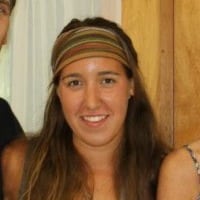Defining moments:
A high-school cross-country meet.
A doctor’s office.
A six-minute defeat.
“I always call them defining moments,” Angela Shartel explained.
They are the life lessons, the experiences, the moments that come forth within races, while sitting at the kitchen table, while standing on a scale in a cold office. Each time she is put to the test, a test with only one question: “Who am I?”
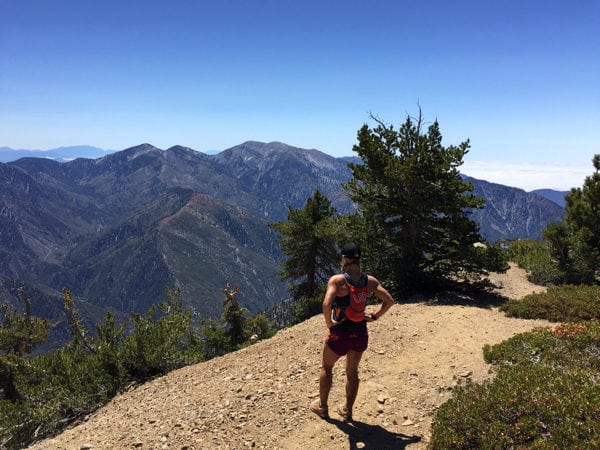
Angela overlooking the Angeles National Forest during a run. Photo: Scott Mills
Angela, 42, was born in Japan, a “military brat” of U.S. Navy personnel. She spent her childhood living on multiple military bases, often feeling a sense of cabin fever, the desire to leave the base and see what else was out there. She joined high-school sports for the opportunity to travel outside the city and sometimes the country to play against other military-base teams. “I was a tomboy as a kid, which is probably not uncommon with us women ultrarunners,” she explained.
She eventually joined cross country after learning the team’s big race was in Korea. “I was never good at any of the sports,” she claimed, and cross country turned out to be the same. “It was awful. The running was just awful. I questioned whether it was worth the trip to Korea.”
That question, that trip, became one of her defining moments. After flying to Korea, on the morning of the race, Angela woke up and dropped out, telling her teammates and coach she was sick. “I really just didn’t like it that much,” she said. That decision, which was not such a significant moment at that time, has become a critical feature of the person and athlete she is now.
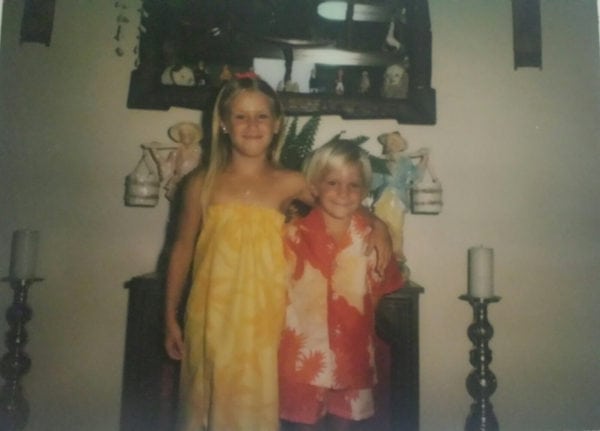
A 10-year-old Angela and her little brother in their home in Guam in 1984. All photos courtesy of Angela Shartel unless otherwise noted.
“At that time, it was a very selfish decision and I felt a little embarrassed. Now, as an adult, I often think about that trip and how I let people down. How I let myself down.” It became a deep, critical lesson, she said. “I don’t want to be… I don’t know…” she trailed off. “It’s probably not as significant as I make it, but if you have that one thing in your life you think back on constantly… That example is a time where I fell short but didn’t have to.”
That memory accompanies her on long training runs in the mountains of San Diego, California, where she now lives, and during the many ultramarathons she has competed in since 2008. It is one of the moments which now helps her surge her through the rough patches.
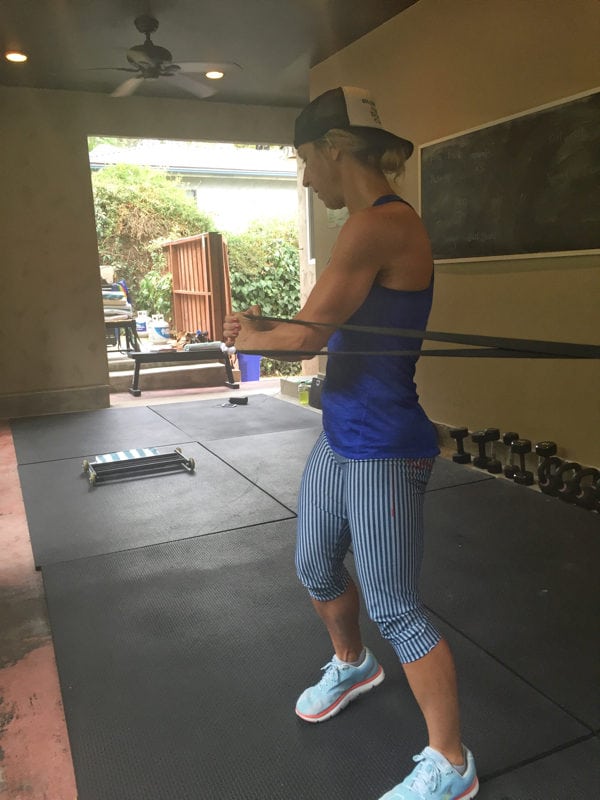
Amidst a strength-training session. Photo: Aubyn Grant
During a 100 miler, Angela keeps herself in the present moment, a state of being she has and will continue to work hard to achieve. For many years, though, she kept her body and mind as numb as possible. She arrived in the United States a little before her 18th birthday, enrolling in community-college classes for early-childhood development, and meeting her then husband, to whom she is no longer married. Angela was forced to rest from exercise and work as a result of a high-risk pregnancy for a daughter who was born with a serious heart condition.
The once-active, social Angela began slipping into a lost world. “It stemmed from when I got pregnant. That’s when everything really came to a head in my life with stress,” she said. A list of factors weighed her down into a depression: The newborn required 24/7 surveillance and two heart surgeries within the year she was born. At the time, Angela’s strained marriage began to crumble and she also discovered she was pregnant with her second daughter soon after. She had trouble losing the initial weight gained during her first pregnancy, about 40 pounds, and she began the yo-yo battle of losing weight, then gaining all and more back.
“It was a combination of a lot of stresses in my life that I didn’t handle well. I turned to food. I was a very emotional eater,” she admitted. “I spent a lot of time alone. My daughter became my world, then my second daughter came, and that’s just where I put everything.” She also gave birth to a son, who is 14 years old. The girls are now 18 and 20.
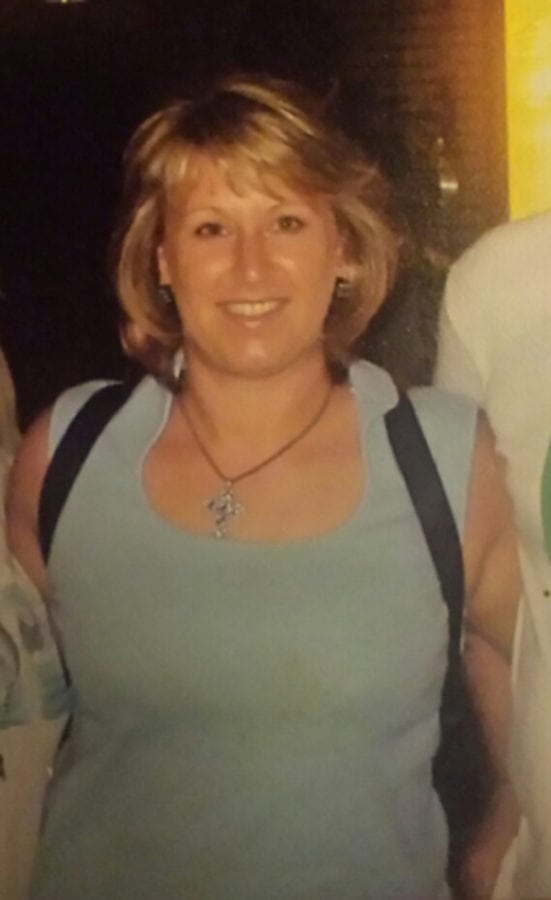
Angela in 2004.
Before she knew it, Angela arrived at a routine doctor’s check-up in December of 2004 to up the doses of medications for high blood pressure, anxiety, and depression. It was at this visit that she found out that she had been gaining a steady 10 to 15 pounds a year for the past few years and was borderline diabetic. She was nearly ready to accept the doctor’s recommendations for higher doses, wanting whatever was needed to numb the feelings she had and any thoughts of positive change.
“I didn’t know myself anymore. I was just trying to numb myself and it wasn’t working,” she explained. “My quality of life wasn’t good and I was just a spectator in my kids’ lives and my own.” She outright said to her doctor, “No. What if we go the other way? What if we get off all the meds? How do we do that?”
What the doctor recommended (and ask your personal doctor before trying something like this yourself) was to set a goal weight, 135, and add a zero to estimate the number of calories to be eaten each day in order to lose weight. She went home and crazily indulged in a binge of eating, she said, scared and upset about how hard this path was going to be.
January 1, 2005 came and Angela started off the year attacking each pound. She weighed herself at 200 pounds, created a three-times-a-week workout plan, and began tracking her calories. It was a diet packed with more fruits and vegetables, but the cravings of her former diet won her over once within the first week.
“After a week, I was like, ‘I’m tired of all these veggies,’ and I had a hamburger and ice cream. I blew the calorie count early in the day and it was a defining moment,” she said. “I sat there. It was around noon and I had reached my calorie count. I needed to decide if I was going to be that person who said, ‘Okay, well, just eat smart at dinner and start again tomorrow,’ or if I was going to say, ‘Alright, this is what you gave yourself today. You really blew it and you cannot eat anything the rest of the day.’ As a challenge to myself and to the commitment I made, I went to bed hungry and mad that I screwed up. After that I became even more focused.”
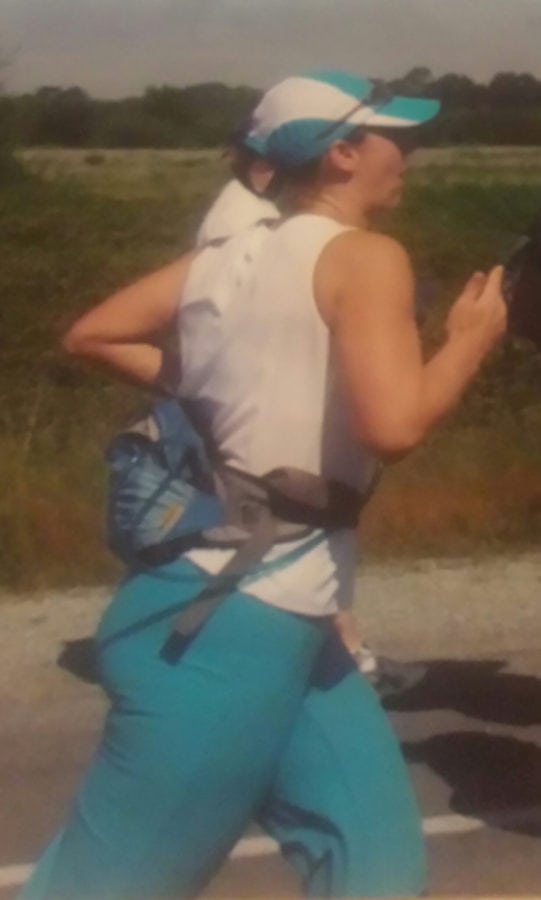
Angela running her first marathon in 2006.
Within a few months, the weight was dropping off, she said, and she learned how to create and eat healthy meals that left her feeling full and satisfied. As the year went on, however, her weight loss plateaued and her fatigue levels increased. The physician, who happened to be a good friend, explained to Angela that her amplified workouts, which had progressed from group-exercise classes to the treadmill, elliptical, and weight-lifting sessions, required more calories for the energy she was burning.
“Each time I changed things I learned new lessons about diet and the quality of food,” she explained. “Ultimately, I got off all the medications. Everything straightened itself out. The depression went away and the anxiety went away.” By the end of the year, she had dropped 65 pounds, weighing in at 140. She was still devastated by the number, having missed her goal by five pounds.
“I saw it as a total failure,” she said. “I found myself sinking back into the depression.” But that same physician who helped Angela get on the track toward healthy and fit recommended that the two of them participate in the Big Sur Marathon Events 21 Miler, something the physician does every year. Angela decided it was either do this race or sit back on the couch and let her old self take over her body. The next day, she went outside and started running.
“I thought I was going to die,” she said laughing about that first training run. “I was dripping with sweat immediately. It didn’t start off so well, so I tried walking and that really hurt my ankles. Then I tried to lightly jog and settled into jogging.”
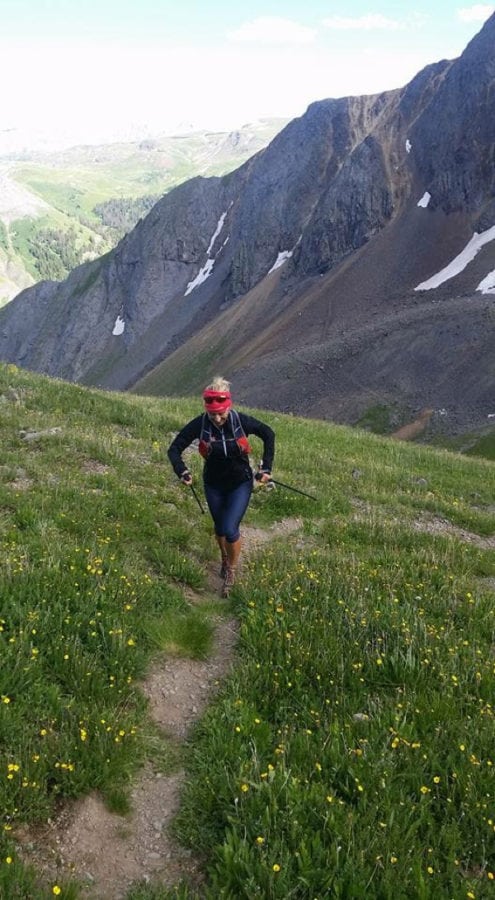
Angela on the Hardrock course. Photo: Scott Mills
Over a span of four months, her 14-minute mile dropped to a nine-minute mile and her daily miles began attracting the attention of neighbors. They kept asking her if she was training for the marathon, a word that was new to her. She asked her friend what it was, and learned it was a 26-something-mile run.
“Nobody knows about this 21 miler we’re training for!” Angela exclaimed. “I want to do the marathon! It’s only five more miles. I’ve been busting my butt!” At the race pick-up, she convinced the race director she could run the marathon and the next morning she was there, terrified and excited, standing on the starting line. “I ended up finishing the marathon and it proved to be one of the hardest and most rewarding things I have ever done and that’s how I caught the bug for running,” she said.
This defining moment led to the next four years of fast marathons, including a 3:06 Boston Marathon in 2009, until that same friend dragged her to the trails. “She was like, ‘Oh, isn’t this so much fun?’” She asked Angela while they were running through the trails near their San Diego homes. “I said, ‘No. These rocks… my ankles are twisting and turning. I can’t get any rhythm.’ It was awful.” Angela promised she would stick it out for two weeks, but those 14 days ended up being more than enough time to fall in love.

Stopping for a picture mid-run with two of Angela’s most influential mentors, Scott Mills (right) and Tracy Moore.
Angela’s first trail marathon was the Catalina Eco-Marathon and it was there when she discovered her next defining moment. “I kept seeing these t-shirts with the numbers of 100 and 60 and I’m nudging my friend like, ‘Is that a running shirt? Are they talking about running? Oh my God, is that even possible?’” she recalled. While registering, she saw the category of names listed for the next distance up, the 50k.
“What is a 50k?” she asked someone.
“Thirty-one miles.”
“Well, that’s only five more miles!” she remembered saying, again surprised by the short-and-sweet five-mile addition.
“I go and I think, I can do a 50k,” she said.
Soon after, she was running her first ultra, the Over the Hill Track Club High Desert 50k Ultra in 2008 in California, winning the first female spot. From there she knew already she had found her thing and it was only a matter of time before she entered and finished 100 miler. Her first 100 was in 2009 in her hometown, the San Diego 100 Mile, and she finished third female in 21 hours and 17 minutes.

At the finish line with Scott Mills after her first San Diego 100 Mile in 2009.
It was during that race when she redeemed herself to her now good friend, training partner, and previous WeRunFar interviewee, Scott Mills. The previous year, Mills was directing one of his races, the Noble Canyon 50k. Days before the start, Angela called up Scott to ask if she could please run the already filled race. “I normally don’t do this…,” he said, but he made an exception for the new ultrarunner. With the promises to arrive early and bring cash, Angela said she would be there and ready to race.
“Saturday morning rolls around and she never shows up,” Mills said. “I’m mad. I’m ticked off, you know, because she’s a no show.” Monday morning came with a telephone call. “’Scott, this is Angela Shartel. I’m so, so sorry. I thought the race was on Sunday not Saturday. I got there on Sunday and went to the start and no one was there,’” he said, recounting his phone call, laughing at the memory. Mills refused the payment she was going to send him for the trouble, but did accept her friendship as the two began training together.
Now, Angela works as the assistant race director for the San Diego 100, organizing the volunteers. “I depend heavily on her. She helps me all weekend,” he said. Mills is actually grooming Angela to take over the race, as he begins to pull out of his big race-directing responsibilities. “I want to give it to somebody I can trust to carry on the event with the reputation and standards we have implemented. I think she’s going to be a terrific race director.”
In 2010, Angela finished Western States, coming in ninth woman in the prestigious event. She completes about four to five ultras a year, traveling the width of the country. “I feel like the 100 miler is for me,” Angela said. “It is the distance that takes you to the bottom. It takes you to the end of who you are and you’re forced to look at yourself. Do I keep going or do I stop?”
“Whatever you’re hiding,” she continued, “whatever you’ve buried, and the things you don’t even know about, they find you in a 100 miler.”
And, she likes that. When picking a race, she chooses based on the possibility of experiencing something new and of learning a life lesson. If she is going to hurt and suffer, she wants to do so in a place that moves her, she said, noting her desires of rocky and technical terrain, warmer temperatures, and lots of climbing.
“I love point to point,” she added in. “I love to feel like I’m going somewhere and that I am on a journey.”
She cannot pinpoint a favorite race because she looks at each one as a different life lesson, not wanting to make one lesson more important than another. Looking back over the memories, the miles of pain and then the miles of laughter, the people who helped her prepare and finish, and so many other factors, this makes trying to select a favorite impossible.
When she picks a race, such as the Bear 100 Mile, she doesn’t compare training and racing plans to other 100s, even if it was another mountainous, technical race, she explained.
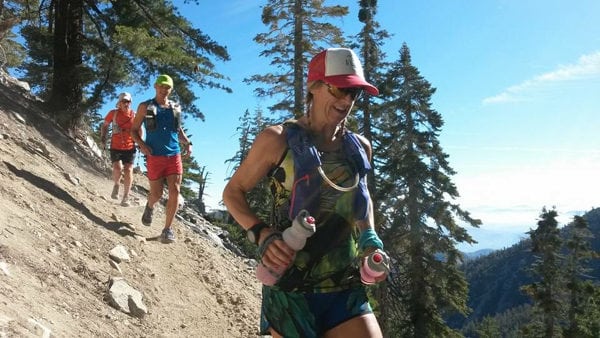
A group run on Mount Baldy in California.
“I feel like one of my strengths in the 100 miler is that I don’t see each 100 miler the same. I take everything separate, everything is compartmentalized for each race,” she said. Even if repeating the race another year–which she doesn’t do often–she returns to a race without comparisons or expectations.
Running the Angeles Crest 100 Mile Endurance Run in 2012 and again in 2013 is such an example, two very different adventures full of life lessons and, yes, another defining moment. Each year, Angela picks the race, plans her mileage, adds in her cross training, and then after some time, she predicts her finish time based off how her body feels during training. For Angela, her weekly mileage begins at 80, and then peaks at 110. Other San Diego runners usually accompany her long runs in the mountains and she does her weekly runs by herself. She incorporates cross training, usually indoor cycling, about three times a week, plus three more strength-training workouts.
Her diet takes on a flexible approach, eating healthy 80 to 90 percent of the time, but not ignoring her cravings for a cheeseburger or pizza, she said.
She plans out her training week by week, tweaking here and there when her body calls for it. “Your body will speak volumes to you and if you learn to listen to it. That makes you more in tune on a day-to-day basis,” she said.
For that first Angeles Crest 100, everything was going well. Her training had her predicting a 22-hour finish time, which when she finally looked at the race logistics, would be close to if not beating the female course record.
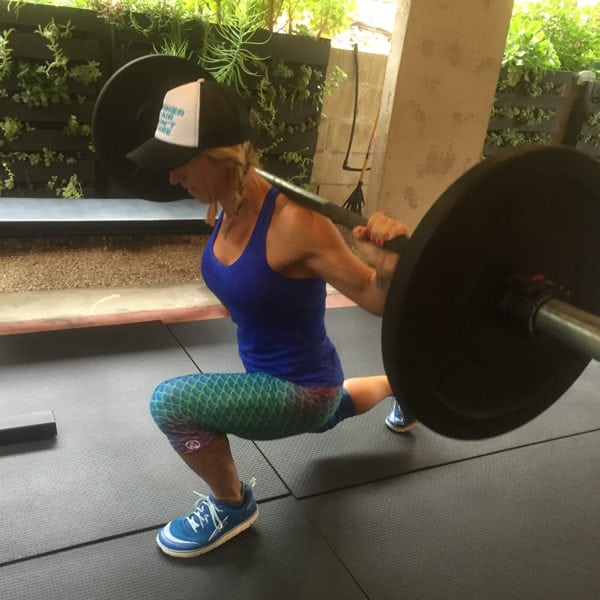
Another weight-lifting session in the gym. Photo: Aubyn Grant
It was about four weeks till the race when she developed the only injury she has ever had in her ultrarunning career, a bad case of plantar fasciitis. She continued to train and decided to run the race, knowing that her 22-hour goal must be changed to a goal of sub-24 hours. That thought was her undoing. “I was running for the wrong reasons, I know I was. I was running despite an injury. I was just running a race and I didn’t want to quit on something I committed to. I was going to prove to myself that I could still do it,” she said. “Then I unraveled.”
After a long day of battling the heat, the dryness, and aches and pains, she came into the finish line six minutes too slow of her sub-24-hour goal. Her first thought, Shame on you. “I foolishly disrespected the course,” she said. Urged on by an unwillingness to quit and surrender, Angela went into Angeles Crest 100 with an arrogance she didn’t know was there until after the race, she said. “I became humbled when I missed my goal and I realized how foolish it was that I let that stubbornness take me to that place where I ultimately disrespected the course,” she said.
Angela believes one disrespects the essence of a race by showing up unprepared, unfit, and in the mindset of a competitor set on a time, rather than a competitor running for his or her best effort.
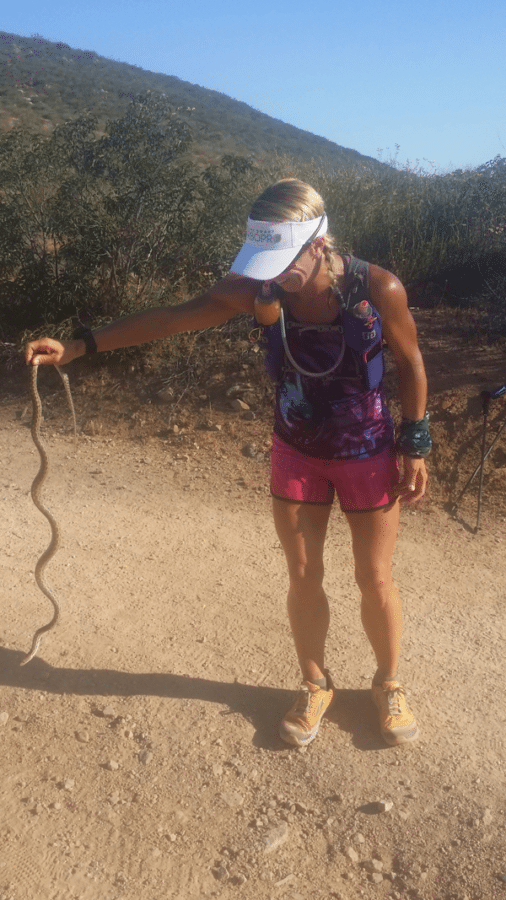
Angela playing with snakes in Mission Trails Regional Park in California.
In 2013, after a year of similar training, but with entirely different focus, she returned, ready to race as Angela Shartel races, moving with the mountain and racing for a life lesson. “Moving with the mountain,” a phrase coined by Angela, is having the discipline to walk when there is a hill, to take the cool breeze when the mountain gives it to you, or taking a moment to slow down through a stifling-hot rough patch.
“’I’m here to work with the mountain,’” she remembered saying to herself while standing on the starting line once more. “’I’m here to love the course.’ I went back ready to embrace knowing this is going to be tough, knowing this will take me places I’ve never been, and I was excited to find out what I would learn.”
From start to finish Angela ran, appreciating where she was and thankful for the second chance. She didn’t run for a time, but ran giving it her best. “When you’ve prepared your best and when you can maintain that, I feel like that is when you give your best, whether if it’s a win, a podium, or a best time, it’s going to be the best and there will not be any regrets,” she explained. In 2013, she accomplished her best, finishing fourth overall, first female, and setting the then course record of 21 hours and 21 minutes. (Pam Smith now holds the course record at 21:04.)
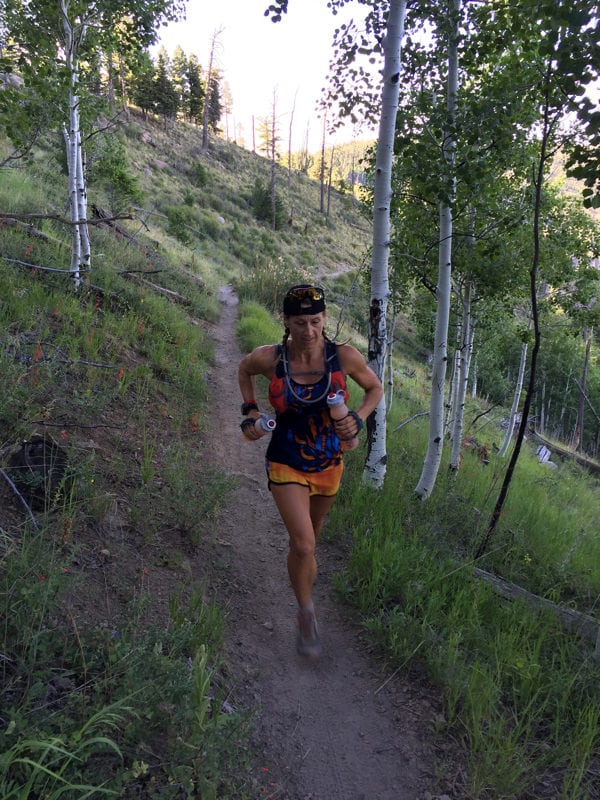
Flying through the trails in Flagstaff, Arizona.
Now ending 2016, Angela looks over the notes and past training plans, reliving each race’s life lesson, which are all confirmations on how the sport of ultrarunning has changed her into the person she is now. She looks forward to aiming for Hardrock some day, when the lottery chooses her, and toward the goal of completing all race distances in one year, starting with the Antelope Canyon Ultramarathon 50k this coming February.
Angela claims there have been too many self-discoveries to name or to try to condense into one article on how ultrarunning has helped in her life. “The consistency within ultrarunning, I’ve learned who I am, learned how to be present, how to work through things, acceptance…” she said. “My life turned from a mental negative to a mental positive.”
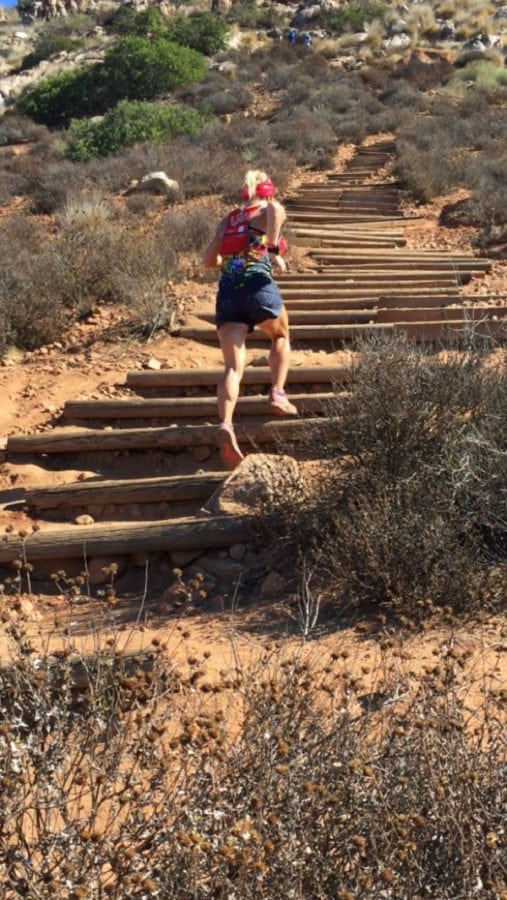
Sprinting up the South Fortuna stairs in Mission Trails Regional Park in California.
She’s applied these qualities to her everyday life, growing herself and her relationships with others. “I’ve become a more giving and compassionate person,” she said. “And, at this time, more than anything, I want to share what I’ve learned. I want to help others, to teach them and show them. I want to give them the desire to find in themselves what they want and help give them the tools to do it.”
Mills says this desire to help others, to volunteer at races for hours, is one of Angela’s strongest qualities as a runner. “She’s very good with people,” he said. He says that she is passionate about the sport, has extreme mental toughness, and gives a lot of time selflessly to helping others, which are all qualities of a good race director.
It also makes for a good coach and motivator, roles Angela has just stepped into. Angela just launched her Ultra Transformation Camp, a dream of hers for years. “I have a deep desire to help others reach their full potential,” she said.
It was ultrarunning–moving forward in the right direction–that has given her the confidence and the health needed to liberate her from the insecure, numb person she once was. “I think ultrarunning made me feel strong, not powerful, but strong in the sense that I can take care of myself. I am going to be okay. I can work through this,” she said.
Call for Comments (from Meghan)
Do you know Angela Shartel? If so, can you share stories about her? Leave a comment!
